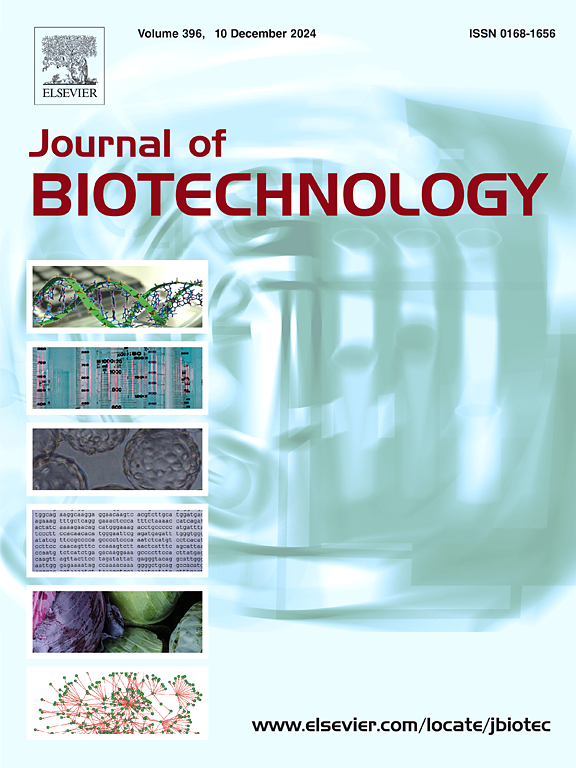A universal single-plasmid, single-promoter system for efficient protein display and RNA encapsulation in MS2 virus-like particles
IF 3.9
2区 生物学
Q2 BIOTECHNOLOGY & APPLIED MICROBIOLOGY
引用次数: 0
Abstract
Bacteriophage MS2 virus-like particles (VLPs) represent a promising platform for biomedical applications. However, challenges remain in integrating protein display, RNA encapsulation, and convenient purification methods. Here, we developed a universal single-plasmid single-promoter system (USS) that enables modular assembly of multifunctional VLPs through designated PstI (protein insertion) and KpnI (RNA encapsulation) sites. The USS system achieved: 1) Efficient display of large protein molecules (e.g., EGFP, Nanobody N16) on each VLP surface while encapsulating target RNA; 2) Rapid one-step purification via His-tag affinity chromatography, bypassing ultracentrifugation; 3) The resulting VLPs exhibit thermal stability (60°C for 15 min) and nuclease resistance. Functional validation demonstrated: 1) Diagnostics: CoviN-encapsulated VLPs served as RT-qPCR controls for COVID-19 detection (linear range: 102–108 copies/μL); 2) Dual functionality for co-delivery: N16-VLPs with shPCSK9 suppressed protein PCSK9 expression by 68 % (p < 0.01) in Hepa1–6 cells and bound PD-L1 with nanomolar affinity (EC50 = 1.6 μg/mL). Crucially, the simplicity of USS eliminated the need for multi-plasmid constructs, providing a streamlined approach to VLPs production that is both efficient and scalable for applications from molecular diagnostics to combination therapies.
在MS2病毒样颗粒中高效蛋白展示和RNA封装的通用单质粒、单启动子系统。
噬菌体MS2病毒样颗粒(VLPs)是生物医学应用的一个有前途的平台。然而,在整合蛋白质展示,RNA封装和方便的纯化方法方面仍然存在挑战。在这里,我们开发了一种通用的单质粒单启动子系统(USS),可以通过指定的PstI(蛋白质插入)和KpnI (RNA封装)位点进行多功能VLPs的模块化组装。USS系统实现了:1)在包封靶RNA的同时,在每个VLP表面高效地展示大分子蛋白(如EGFP, Nanobody N16);2)通过his标签亲和层析快速一步纯化,绕过超离心;3)所得的VLPs具有热稳定性(65°C, 15min)和核酸酶抗性。功能验证表明:1)诊断:covin包封的VLPs可作为RT-qPCR检测COVID-19的对照(线性范围:102-108拷贝/μL);2)共递送的双重功能:N16-VLPs与shPCSK9在Hepa1-6细胞中抑制PCSK9蛋白表达68% (p < 0.01),并以纳米摩尔亲和力结合PD-L1 (EC50= 1.6μg/mL)。至关重要的是,USS的简单性消除了对多质粒构建的需求,为从分子诊断到联合治疗的应用提供了一种高效且可扩展的VLPs生产方法。
本文章由计算机程序翻译,如有差异,请以英文原文为准。
求助全文
约1分钟内获得全文
求助全文
来源期刊

Journal of biotechnology
工程技术-生物工程与应用微生物
CiteScore
8.90
自引率
2.40%
发文量
190
审稿时长
45 days
期刊介绍:
The Journal of Biotechnology has an open access mirror journal, the Journal of Biotechnology: X, sharing the same aims and scope, editorial team, submission system and rigorous peer review.
The Journal provides a medium for the rapid publication of both full-length articles and short communications on novel and innovative aspects of biotechnology. The Journal will accept papers ranging from genetic or molecular biological positions to those covering biochemical, chemical or bioprocess engineering aspects as well as computer application of new software concepts, provided that in each case the material is directly relevant to biotechnological systems. Papers presenting information of a multidisciplinary nature that would not be suitable for publication in a journal devoted to a single discipline, are particularly welcome.
 求助内容:
求助内容: 应助结果提醒方式:
应助结果提醒方式:


